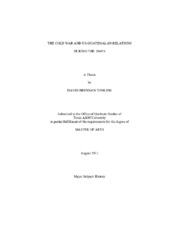| dc.contributor.advisor | Kirkendall, Andrew J. | |
| dc.creator | Tomlins, David Brennan | |
| dc.date.accessioned | 2012-10-19T15:29:19Z | |
| dc.date.accessioned | 2012-10-22T17:59:27Z | |
| dc.date.available | 2012-10-19T15:29:19Z | |
| dc.date.available | 2012-10-22T17:59:27Z | |
| dc.date.created | 2011-08 | |
| dc.date.issued | 2012-10-19 | |
| dc.date.submitted | August 2011 | |
| dc.identifier.uri | https://hdl.handle.net/1969.1/ETD-TAMU-2011-08-10026 | |
| dc.description.abstract | During the 1960's Guatemalan stability began to falter due to a political and social breakdown; guerilla violence and government repression emerged from this decade as common occurrences. In response to the instability within Guatemala, the US focused on providing significant financial aid to bolster a weak economy, while simultaneously working with the Guatemalan police and military to create more efficient and modern internal security forces capable of combating Communist subversion. Despite US attempts to foster stability, in 1963 President Miguel Ydigoras Fuentes was removed from office by a military coup organized by his opponents within Guatemala.
The Lyndon B. Johnson administration continued to support the Guatemalan government and continued to provide economic and military assistance. Despite US assistance, the internal social and political divisions in Guatemala continued to result in violence. In the midst of the escalating violence, elections were held in 1966 and the center left candidate Julio Cesar Mendez Montenegro was elected as the new president of Guatemala. The election of a politically left president further radicalized the Guatemalan right, which resulted in attempted coups and acts of terror. The violence from the leftist guerillas and the radical rightist elements forced Mendez Montenegro to allow the military to use harsh counter-terror strategies to bring the country under control. Despite negative developments, the US consistently tried to help build Guatemalan stability. Unfortunately, its policies ignored the socio-economic inequalities, and internal division which was the biggest problem facing the nation. The internal political division that created the violence and instability made it impossible for any US assistance to have a meaningful impact. During the 1960's these developments in Guatemala paved the way for the violence and genocide of the 1980's and solidified a policy of US involvement that was inadequate and ineffective. | en |
| dc.format.mimetype | application/pdf | |
| dc.language.iso | en_US | |
| dc.subject | Guatemala | en |
| dc.subject | United States diplomatic relations | en |
| dc.subject | Cold War | en |
| dc.subject | Lyndon B. Johnson | en |
| dc.subject | John F. Kennedy | en |
| dc.subject | Guatemalan Civil War | en |
| dc.subject | 1960's | en |
| dc.subject | Ydigoras Fuentes | en |
| dc.subject | Mendez Montenegro | en |
| dc.subject | Peralta Azurdia | en |
| dc.title | The Cold War and US-Guatemalan Relations During the 1960's | en |
| dc.type | Thesis | en |
| thesis.degree.department | History | en |
| thesis.degree.discipline | History | en |
| thesis.degree.grantor | Texas A&M University | en |
| thesis.degree.name | Master of Arts | en |
| thesis.degree.level | Masters | en |
| dc.contributor.committeeMember | Chambers, Glenn | |
| dc.contributor.committeeMember | Taylor-Robinson, Michelle | |
| dc.type.genre | thesis | en |
| dc.type.material | text | en |


